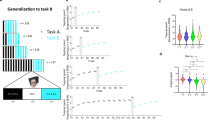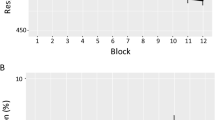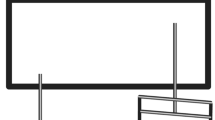Abstract
The skilled generation of motor sequences involves the appropriate choice, ordering and timing of a sequence of simple, stereotyped movement elements. Nevertheless, a given movement element within a well-rehearsed sequence can be modified through interaction with its neighboring elements (co-articulation). We show that extensive training on a sequence of planar hand trajectories passing through several targets resulted in the co-articulation of movement components, and in the formation of new movement elements (primitives). Reduction in movement duration was accompanied by the gradual replacement of straight trajectories by longer curved ones, the latter affording the maximization of movement smoothness. Surprisingly, the curved trajectories were generated even when new target configurations were introduced, i.e., when target distances were scaled, movement direction reversed or when different start and end positions were used, indicating the acquisition of geometrically defined movement elements. However, the new trajectories were not shared by the untrained hand. Altogether, our results suggest that novel movement elements can be acquired through extensive training in adults.











Similar content being viewed by others
References
Abend W, Bizzi E, Morasso P (1982) Human arm trajectory formation. Brain 105:331–348
Adi-Japha E, Levin I, Solomon S (1998) Emergence of representation in drawing: the relation between kinematics and referential aspects. Cogn Dev 13:25–51
Bapi RS, Doya K, Harner MA (2000) Evidence for effector independent and dependent representations and their differential time course of acquisition during motor sequence learning. Exp Brain Res 132:149–162
Berthier NE (1996) Learning to reach: a mathematical model. Dev Psychol 32:811–823
Bizzi E, Tresch MC, Saltiel P, d’Avella A (2000) New perspectives on spinal motor systems. Nat Rev Neurosci 1:101–108
Blackburn CS, Young S (2000) A self-learning predictive model of articulator movements during speech production. J Acoust Soc Am 107:1659–1670
Edelman S, Flash T (1987) A model of handwriting. Biol Cybern 57:25–36
Engel KC, Flanders M, Soechting JF (1997) Anticipatory and sequential motor control in piano playing. Exp Brain Res 113:189–199
Flanagan JR, Rao AK (1995) Trajectory adaptation to nonlinear visuomotor transformation: evidence of motion planning in visually perceived space. J Neurosci 74: 2174–2177
Flash T, Gurevich I (1992) Human motor adaptation to external loads. In: Annual International Conference of the IEEE Engineering in Medicine and Biology Society, vol 13, pp 885–886
Flash T, Henis EA (1991) Arm trajectory modification during reaching towards visual targets. J Cogn Neurosci 3:220–230
Flash T, Hogan N (1985) The coordination of arm movements: An experimentally confirmed mathematical model. J Neurosci 5:1688–1703
Flash T, Henis E, Inzelberg R, Korczyn AD (1992) Timing and sequencing of human arm trajectories: normal and abnormal motor behavior. Hum Move Sci 11:83–100
Ghahramani Z, Wolpert DM (1997) Modular decomposition in visuomotor learning. Nature 386:392–395
Ghilardi MF, Gordon J, Ghez C (1995) Learning a visuomotor transformation in a local area of workspace produces directional biases in other areas. J Neurophysiol 73:2535–2539
Gordon J, Ghilardi MF, Ghez C (1994) Accuracy of planar reaching movements. I. Independence of direction and extended variability. Exp Brain Res 99:97–111
Hardcastle W, Marchal A (1990) Speech production and speech modeling. Kluwer Academic Press, Dordrecht
Hikosaka O, Rand MK, Miyachi S, Miyashita K (1995) Learning of sequential movements in the monkey: process of learning and retention of memory. J Neurophysiol 74:1652–1661
Hikosaka O, Nakahara H, Rand M.K, Sakai K, Lu X, Nakamura K, Miyachi S, Doya K (1999) Parallel neural networks for learning sequential procedures. Trends Neurosci 22:464–471
Hofsten C (1991) Structuring of early reaching movements: a longitudinal study. J Mot Behav 23:280–292
Hollerbach JM, Flash T (1982) Dynamic interaction between limb segments during planar arm movements. Biol Cybern 44:67–77
Jacobs S, Hanneton S, Heude S, Roby-Brami A (2003) Is the velocity–curvature relationship disrupted in apraxic patients? Neuroreport 14:1907–1911
Jerde TE, Soechting JF, Flanders M (2003) Coarticulation in fluent finger spelling. J Neurosci 23:2383–2393
Karni A, Meyer G, Jezzard P, Adams MM, Turnder R, Ungerleider LG (1995) Functional MR evidence for adult motor cortex plasticity during motor skill learning. Nature 377:155–158
Karni A, Meyer G, Rey-Hipolito C, Jezzard P, Adams MM, Turner R, Ungerleider LG (1998) The acquisition of skilled motor performance: fast and slow experience-driven changes in primary motor cortex. Proc Natl Acad Sci USA 95:861–868
Kent RD, Minifie FD (1977) Coarticulation is recent speech production models. J Phonetics 5:115–133
Konczak J, Borutta M, Topka H, Dichgans J (1995) The development of goal-directed reaching in infants: hand trajectory formation and joint force control. Exp Brain Res 106:156–168
Krebs HI, Aisen ML, Volpe BT, Hogan N (1999) Quantization of continuous arm movements in humans with brain injury. Proc Natl Acad Sci USA 96:4645–4649
MacNeilage PF (1980) Speech production. Lang Speech 23:3–22
Morasso P (1981) Spatial control of arm movements. Exp Brain Res 43:223–227
Morasso P, Mussa-Ivaldi FA (1982) Trajectory formation and handwriting: a computational model. Biol Cybern 45:131–142
Mussa-Ivaldi FA, Bizzi E (2000) Motor learning through the combination of primitives. Phil Trans R Soc Lond B 355:1755–1769
Nudo R, Millike GW, Jenkins WM, Merzenich MM (1996) Use-dependent alterations of movement representations in primary motor cortex of adult squirrel monkeys. J Neurosci 16:785–807
Rand MK, Hikosaka O, Miyachi S, Lu X, Miyashita K (1998) Characteristics of a long-term procedural skill in the monkey. Exp Brain Res 118:293–297
Rohrer B, Fasoli S, Krebs HI, Hughes R, Volpe B, Frontera WR, Stein J, Hogan N (2002) Movement smoothness changes during stroke recovery. J Neurosci 22:8297–8304
Shadmehr R, Mussa-Ivaldi FA (1994) Adaptive representation of dynamics during learning of a motor task. J Neurosci 14:3208–3224
Todorov E, Jordan MI (2002) Optimal feedback control as a theory of motor coordination. Nat Neurosci 5:1110–1111
Torres E, Zipser D (2002) Reaching to grasp with a multi-jointed arm. I. Computational model. J Neurophysiol 88:2355–2367
Viviani P, Flash T (1995) Minimum-jerk, two-thirds power law, and isochrony: converging approaches to movement planning. J Exp Psychol Hum Percept Perform 21:32–53
Viviani P, Terzuolo C (1982) Trajectory determines movement dynamics. J Neurosci 7:431–437
Wada Y, Kawato M (1995) A theory for cursive handwriting base on the minimization principle. Biol Cybern 73:3–13
Wada Y, Koike Y, Vatikiotis-Bateson E, Kawato M (1995) A computational theory for movement pattern recognition based on optimal movement pattern generation. Biol Cybern 73:15–25
Wolpert DM, Harris CM (1998) Signal dependent noise determines motor planning. Nature 394:780–784
Wolpert DM, Ghahramani Z, Jordan MI (1995) Are arm trajectories planned in kinematic or dynamic coordinates? An adaptation study. Exp Brain Res 103:460–470
Acknowledgements
We sincerely thank Drs. Magnus Richardson and Felix Polyakov for many helpful discussions and for assistance in modeling the data. This work was supported in part by the Einhorn-Dominic Foundation and by the Morros laboratory.
Author information
Authors and Affiliations
Corresponding author
Additional information
The first two authors contributed equally to this work
Rights and permissions
About this article
Cite this article
Sosnik, R., Hauptmann, B., Karni, A. et al. When practice leads to co-articulation: the evolution of geometrically defined movement primitives. Exp Brain Res 156, 422–438 (2004). https://doi.org/10.1007/s00221-003-1799-4
Received:
Accepted:
Published:
Issue Date:
DOI: https://doi.org/10.1007/s00221-003-1799-4




